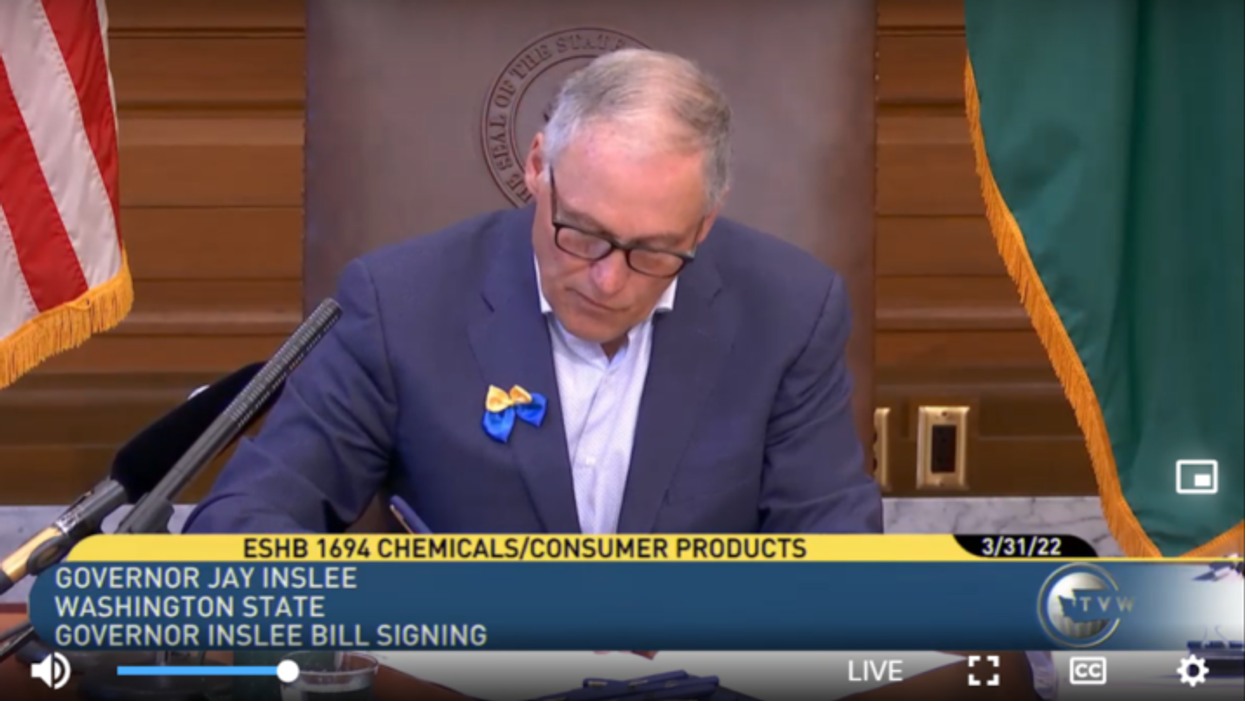
A new Washington state bill, signed into law last Thursday by Gov. Jay Inslee, aims to phase out PFAS in select consumer products by 2025.
It’s the “fastest timeline in the nation,” Laurie Valeriano, executive director of advocacy group Toxic-Free Future, told EHN.
PFAS, which refers to per- and poly-fluoroalkyl substances, are often used in consumer products as an additive, usually to make stain- or water-resistant materials. The chemicals can also be unintentionally introduced into products via manufacturing or packaging, and are linked to multiple negative health outcomes including some cancers, reproductive problems, and birth defects, among others.
The new bill, HB 1694, bans the use of PFAS in a range of these products, including apparel, non-stick pans, cosmetics, cleaning products, and firefighter gear after 2025.
“We know that these chemicals threaten the health and safety of every plant, animal, and human that calls this state home,” state Rep. Liz Berry (D-Seattle), who sponsored the bill, told EHN. “These chemicals should not be in our products.”
Berry was inspired to create the bill after reading a 2021 study from Toxic-Free Future, which analyzed PFAS in breast milk and found that 100% of women tested had contaminated milk. “I’m a mom of two young kids. I breastfed with my babies,” said Berry. “I was terrified when I read more about what PFAS did, and I asked what I could do.”
While this new bill puts Washington at the forefront of the push to phase out PFAS, other states have taken action as well. In California, PFAS will be banned in paper food packaging as of 2023; a Maine law passed last summer will ban the sale of most products containing PFAS by 2030. In the fight against PFAS, said Berry, states have the most potential to improve regulation. “With federal inaction, we’re the place to get things done,” she said. “Nothing’s getting done in DC.”
Updated PFAS bill
Berry’s new bill speeds up the timeline for regulation of PFAS from a 2019 bill, which aimed for regulation by 2030. “[The bill] allows the Department of Ecology here in Washington to really expedite action on addressing and managing these chemicals in our state,” said Berry.
HB 1694 is now law! It tackles #PFAS in products such as apparel & firefighter gear by 2025, the fastest PFAS timeline in the U.S!
Thank you @LizBerryWA, @joefitzgibbon, @senmonadas, @SenLizLovelett, @WSCFF_UNION & @nickfedwa for your work on this bill!https://t.co/Uexv0jk9Qq pic.twitter.com/iqMYFyPEZu
— Toxic-Free Future (@ToxFreeFuture) April 1, 2022
The original bill that Berry proposed included additional directions for regulation of other priority toxic chemicals such as phthalates and PCBs, in addition to PFAS. However, she said, those components of the bill did not make it into the final legislation because they were blocked in the Senate.
Aggressive PFAS phaseout timeline
The bill’s 2025 phaseout deadline makes Washington the first state to tackle PFAS on an accelerated timeline. “I just don’t think that any more time is necessary to make sure people are safe,” said Berry. “We’ve got to keep industry on their toes, make sure they’re being innovative, so that we’re not poisoning people for their products.”
Valeriano said the timeline puts pressure on industries in Washington state. However, she said, “I think it’s entirely doable to get there in the next few years.”
“It’s just the will and the direction and the regulatory hammer that has to be put in place in order to drive those decisions on a faster timeline,” she said.
Follow our PFAS testing project with Mamavation at the series landing page.
Want to know more about PFAS? Check out our comprehensive guide.
Have something you want tested for PFAS? Let us know and write us at feedback@ehn.org.

